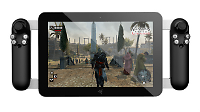Gaming Platform That Is Different!
 Is it a tablet? A PC? A gaming console? A hand held? Well, yes, and no… it is very different!
Is it a tablet? A PC? A gaming console? A hand held? Well, yes, and no… it is very different!
I Just Held the Future of PC Gaming in My Hands and It’s Called Project Fiona
“Project Fiona is a proof-of-concept and a prototype in the most serious way. What you’re looking at is version 0.2. (Razer’s already finished work on five more iterations of Fiona—they’re up to version 0.8 at their labs, and expecting to hit 1.0 by the end of the year.) I can tell when I feel the heat coming out of the vents, as the fan spins up to cool the Intel Core i7 breathing fire inside. Or when the right analog stick feels a little sticky.
But when I run my finger along the edges of the brushed aluminum frame that provides Fiona’s remarkably rigid structural integrity, or try to make its skeleton flex and creak, it feels more done, more solid than some other very finished tablets I’ve used. ‘And frankly, the final product will look much different,’ says Razer CEO Min-Liang Tan of Fiona. Which is also why I can’t tell you battery life, or how much it’ll cost, though Tan is aiming for under $1000 for the Windows 8-powered tablet—meaning it’ll have full PC powers, though Razer is adding some software of their own on the gaming side, like the interface for browsing games. (Side note: Do you remember OQO, a little company that built little computers that were both radically ahead and behind their time? Appropriately, a lot of their engineers worked on this.)
It’s lighter than you’d think, for a tablet that’s at least as thick as three iPad 2s—it’ll be thinner, promises Tan—and has a pair of sticks bolted onto it. But I rest my elbows on my knees to play Warhammer 40K: Space Marine. And it feels totally natural. If you’ve ever used an Xbox 360 or PS3 controller, you know how to use Fiona’s controls; Razer software takes care of the mapping PC controls to the buttons.
Do you know what the minimum spec requirements are for Space Marine? A 2GHz dual-core CPU, 2GB RAM, 256MB video card. And it ran beautifully on Fiona’s glossy 10.1-inch, 1280×800 display. I held PC gaming in my hands, and I killed a bunch of Orcs and it felt fantastic. It sounds stupid that a 10.1-inch screen could be as immersive as a 24-inch display, but when you’re able to bring your game up to your face, and it moves with you and your body, it’s a different kind of connection. Speaking of moving! It’s got an accelerometer and force feedback and a camera, so Razer’s already thinking ways PC games could take advantage of gamers having access to traditional controls, touch and movement simultaneously.”